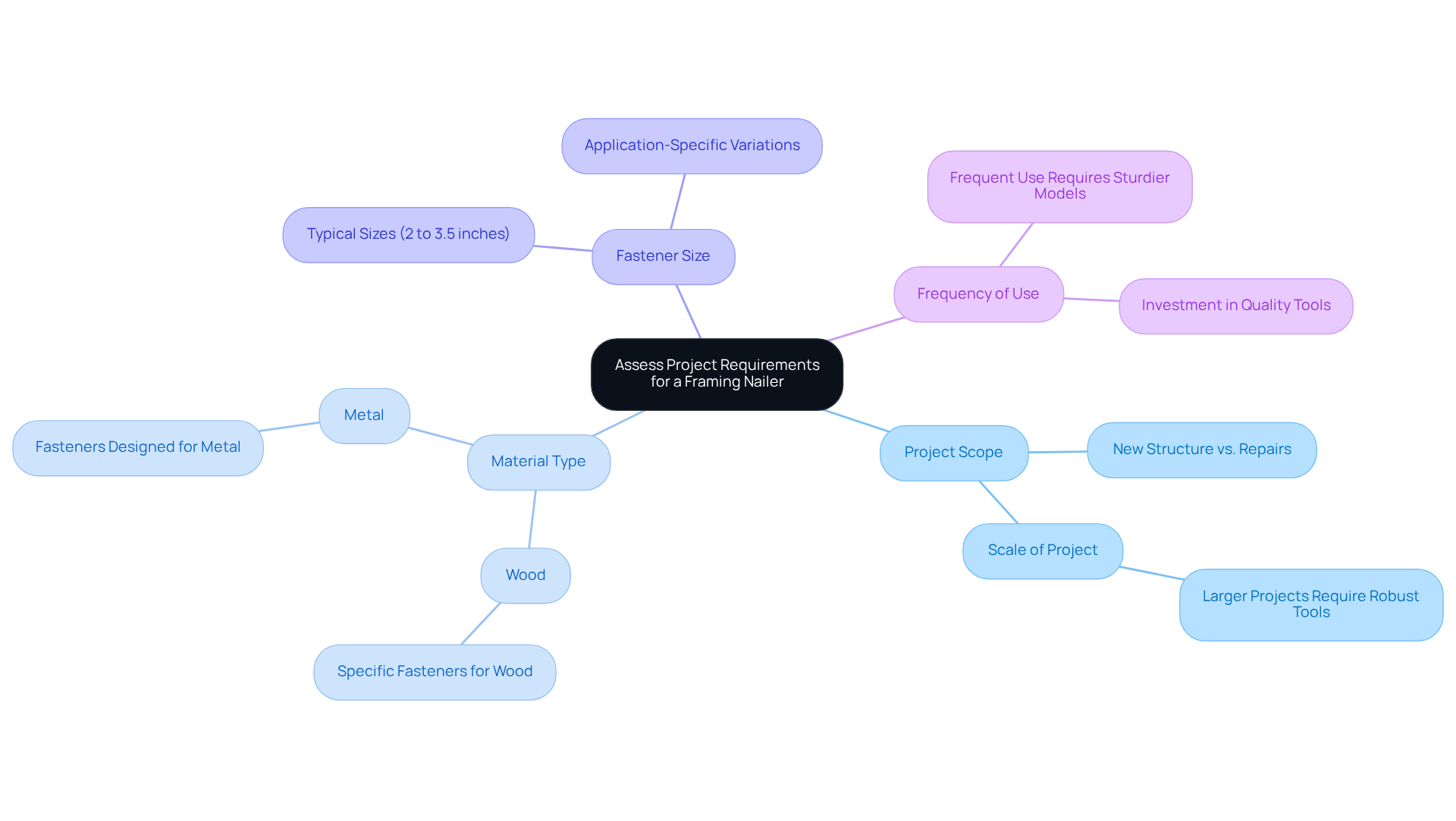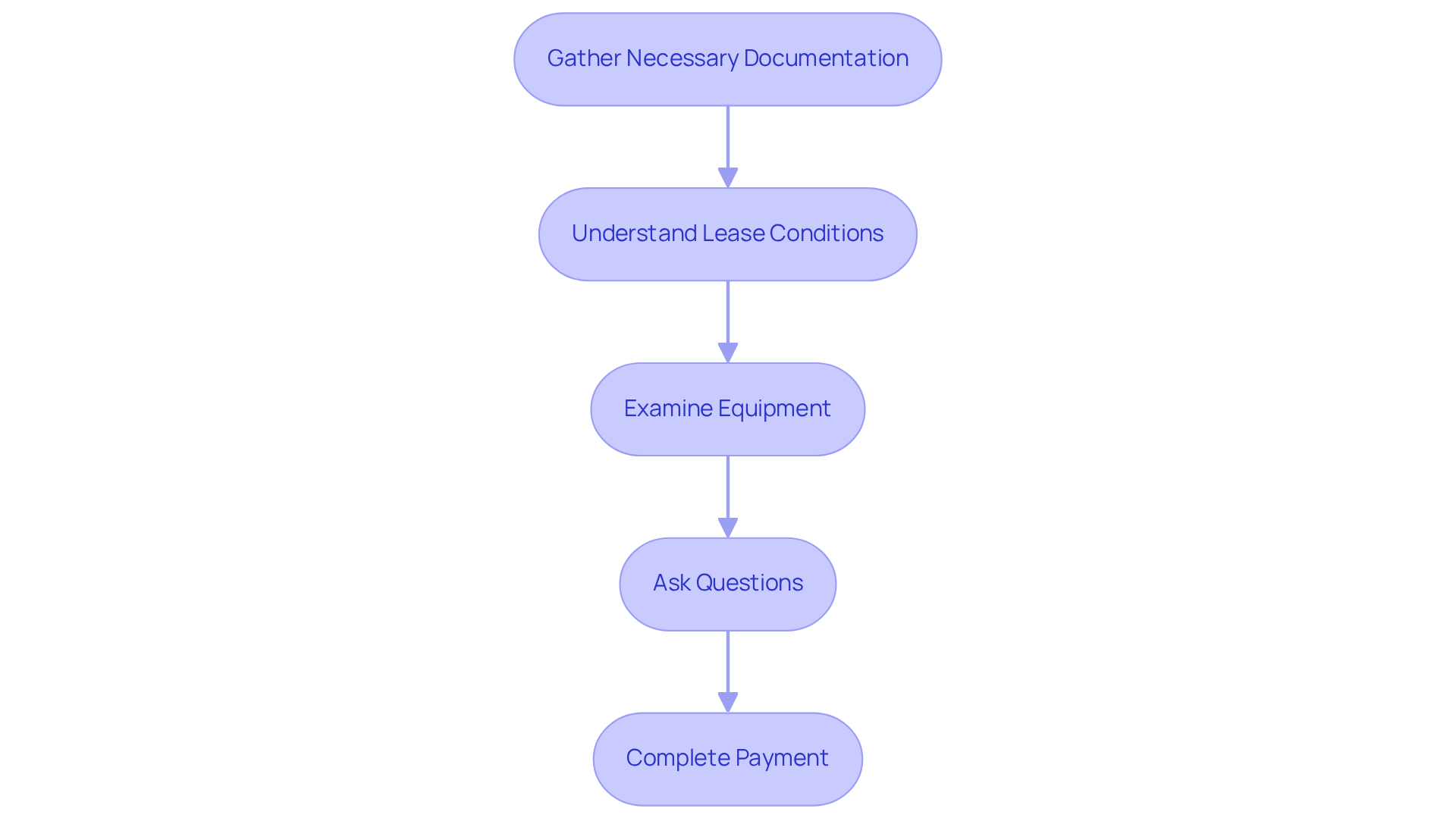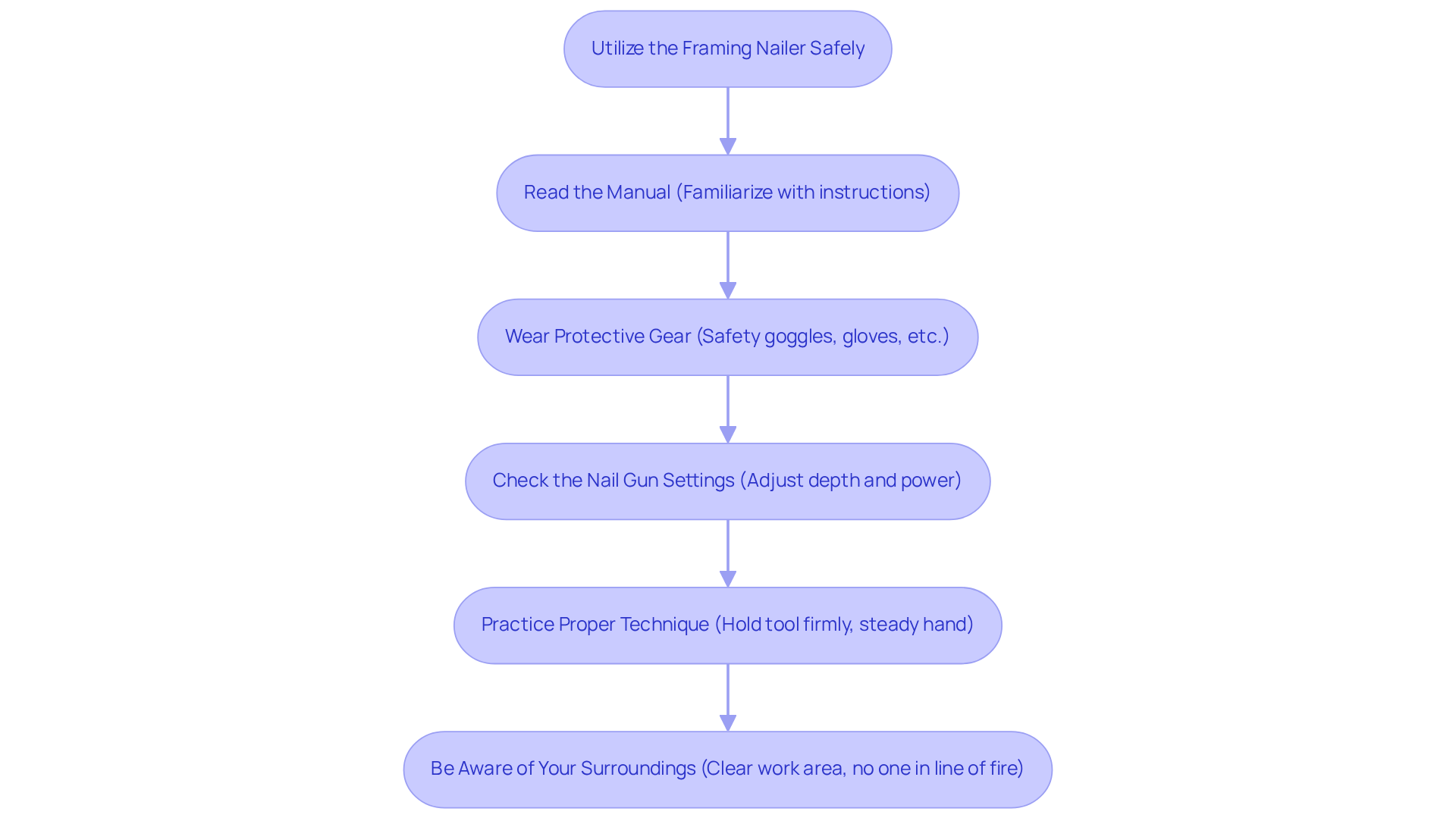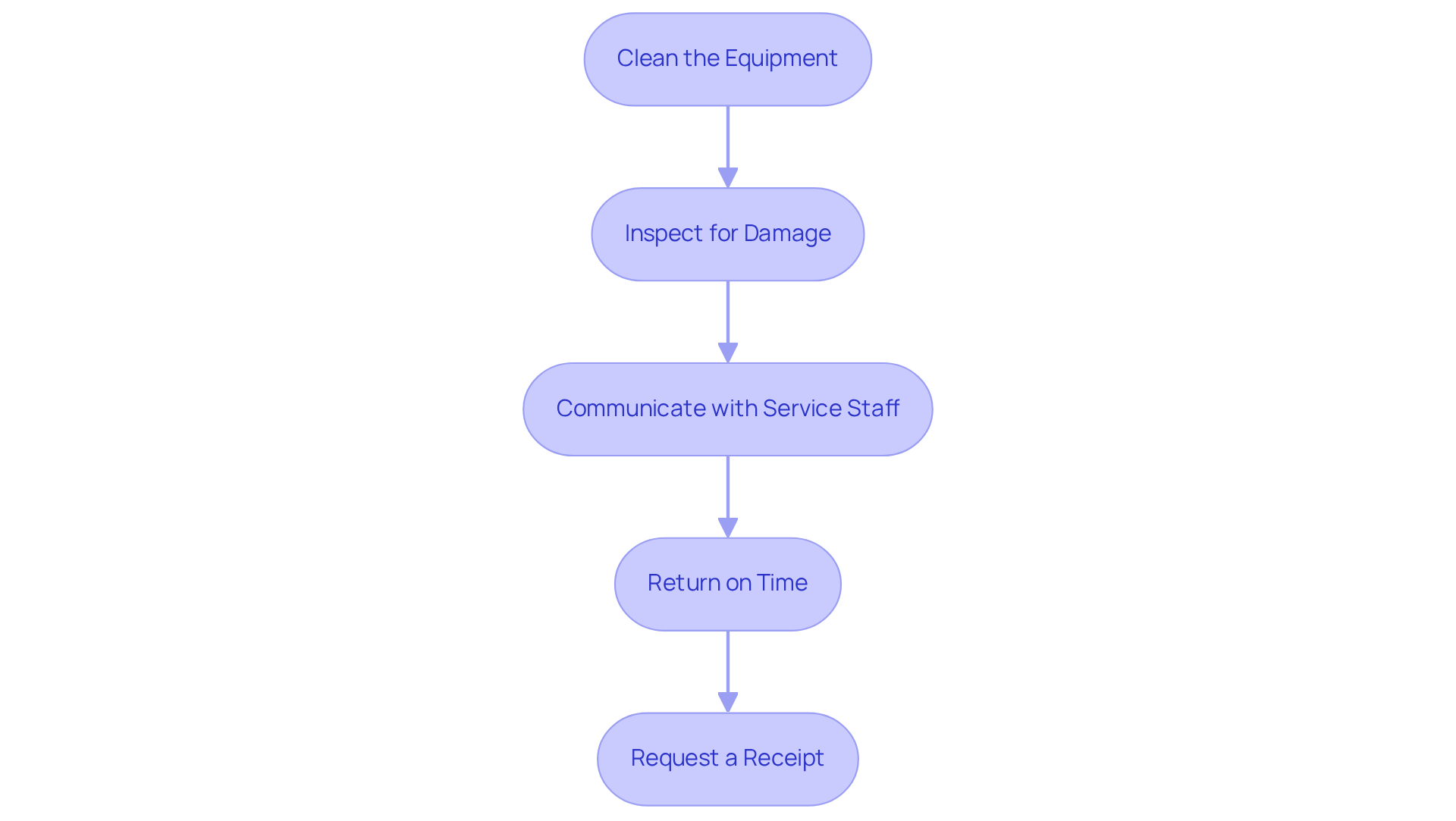Overview
This article outlines five essential steps for renting a framing nailer for construction projects. It emphasizes the importance of:
- Assessing project requirements
- Identifying a reputable rental service
- Completing the rental process efficiently
- Utilizing the tool safely
- Returning it properly
Each step is supported by practical advice and industry insights, such as the necessity to evaluate project scope and material types to select the right tool. This approach ensures a smooth rental experience while minimizing risks and potential costs.
Key Highlights:
- Determine project scope to choose the appropriate framing nailer size and power based on structural work needs.
- Identify material types (wood or metal) to select compatible fasteners for optimal performance.
- Understand fastener sizes (2 to 3.5 inches) required for the project to ensure proper tool functionality.
- Consider frequency of use when selecting a robust tool to enhance productivity and reduce downtime.
- Research local rental options and cheque reviews to find a reputable equipment rental service.
- Inquire about equipment quality and maintenance practises to ensure safety and efficiency.
- Review lease conditions carefully to avoid unexpected fees and ensure compliance with policies.
- Inspect the framing nailer for damage before use and ask questions about operation and safety features.
- Follow safety guidelines, including reading the manual, wearing protective gear, and checking tool settings.
- Maintain a clear work area and practise proper technique to minimise the risk of injuries during use.
- Clean the equipment before returning it and inspect for any damage, documenting issues if necessary.
- Communicate any challenges faced with the rental service and ensure timely equipment return to avoid late fees.
Introduction
Navigating the world of construction projects necessitates specialized tools, and a framing nailer stands out as an essential asset for efficient and effective framing work. Understanding the process of renting this powerful tool can significantly influence the success of any construction endeavor. With a multitude of options and considerations at play, how can one ensure the right choice is made? This guide will explore the key steps for renting a framing nailer:
- Assess project requirements
- Research rental options
- Compare rental costs
- Review safety guidelines
- Ensure proper usage
Ultimately empowering readers to tackle their projects with confidence and expertise.
Assess Project Requirements for a Framing Nailer
Begin by determining the type of structural work you will undertake. Consider these key factors:
- Project Scope: Are you framing a new structure or making repairs? The scale of your project significantly impacts the power and size of the tool required. For larger projects, a more robust framing tool may be essential to handle increased demands effectively. Notably, the U.S. Framing Nailer market is projected to grow significantly, reaching USD 0.7 billion by 2033, underscoring the necessity of selecting the right tool for your project.
- Material Type: Identify the materials you will be using, such as wood or metal. Different types of fasteners are specifically designed for various materials, ensuring optimal performance and results.
- Fastener Size: Understand the size of fasteners needed for your project. Framing tools typically accommodate nails ranging from 2 to 3.5 inches, although this can vary based on the specific application.
- Frequency of Use: If you plan to use the tool frequently, consider whether a more robust model is warranted. Investing in a sturdy tool can enhance productivity and minimize downtime.
As industry experts note, 'Selecting the appropriate fastening tool can greatly influence the productivity and standard of your work.' By thoroughly evaluating these factors, you can ensure that you rent a framing nailer that is tailored to your project needs. This careful consideration is essential, particularly as the demand to rent framing nailer increases in the evolving market for efficient tools in construction.

Find a Reputable Equipment Rental Service
To find a reputable equipment rental service, consider these essential steps:
-
Research Local Options: Start by exploring equipment rental companies in your vicinity, such as EZ Equipment Rental in Irving, TX. This company is recognized for its unwavering commitment to quality and reliability, making it a top choice in the DFW metro area. Their dedication to customer satisfaction sets a high standard in the industry.
-
Check Reviews and Ratings: Investigate customer feedback on platforms like Google, Yelp, or social media. Positive reviews often indicate a strong reputation, while negative ones may highlight potential issues. Notably, 47% of leasing companies reported an increase in equipment leases to contractors in 2022, reflecting a growing trust in service providers.
-
Inquire about Equipment Quality: Reach out to the service provider to ask about their maintenance practices and the overall condition of their rent framing nailer. Ensuring project efficiency and safety is crucial, which highlights the importance of quality when you choose to rent a framing nailer.
-
Evaluate Customer Service: Assess the responsiveness of the leasing company. A willingness to address your questions is a strong indicator of the level of support you can expect throughout the leasing process. As industry expert Martin Placek highlights, the equipment leasing market has experienced consistent growth globally, making it essential to choose a reputable service.
-
Compare Pricing: Obtain quotes from multiple leasing services to ensure competitive pricing. While cost is important, prioritize quality to avoid compromising on the equipment's performance.
By following these steps, you can confidently select a leasing service that aligns with your project needs and expectations. Customer reviews of EZ Equipment Rental often emphasize their excellent service and reliable equipment, reinforcing their strong reputation in the market.

Complete the Rental Process Efficiently
To complete the rental process efficiently, it is essential to follow these key steps:
-
Gather Necessary Documentation: Prepare your identification, proof of address, and any required insurance information. Industry insights reveal that 40.2% of fleet managers have raised maintenance budgets to prolong equipment life, underscoring the importance of proper documentation in streamlining the leasing process and avoiding delays.
-
Understand Lease Conditions: Carefully review the leasing agreement, paying close attention to duration, fees, and penalties for late returns. Understanding these terms can help you avoid unexpected fees and ensure compliance with leasing policies. As Josh Nickell, Vice President of the American Rental Association, states, "You can’t just assume that there’s a piece of equipment on your lot or hope one will be back in time; you have got to do a lot more planning."
-
Examine the equipment carefully before you rent a framing nailer, ensuring to inspect the tool for any visible damage or wear. Confirm that it is in good working condition to prevent issues during your project.
-
Ask Questions: Engage with the staff regarding the operation of the rent framing nailer, its safety features, and maintenance tips. This interaction enhances your understanding and ensures safe usage. Rental professionals consistently highlight the importance of asking questions to clarify any uncertainties.
-
Complete Payment: Finalize the payment process by obtaining a receipt and a copy of the lease agreement for your records. Retaining these documents is crucial for any future reference or disputes.
By following these steps, you can ensure a smooth and efficient rental experience, paving the way for successful project execution.

Utilize the Framing Nailer Safely and Effectively
To utilize the framing nailer safely and effectively, adhere to the following guidelines:
-
Read the Manual: Familiarize yourself with the manufacturer's instructions and safety guidelines before use. Understanding the mechanics and safety features is crucial; improper handling can lead to serious injuries.
-
Wear Protective Gear: Always wear safety goggles, gloves, ear protection, and safety shoes to safeguard against potential hazards. OSHA mandates that construction workers wear safety footwear to guard against puncture tool injuries. Additionally, extra protective equipment like hard hats and eye protection is critical. As construction safety experts indicate, 'Appropriate protective equipment is essential to avoid serious injuries when using fastening tools.'
-
Check the Nail Gun Settings: Adjust the depth and power settings according to the material you are working with. Utilizing the correct settings can prevent unintended nail discharge, a common cause of injuries.
-
Practice Proper Technique: Hold the tool firmly and maintain a steady hand. Ensure the tool is flush against the surface before firing. Studies reveal that the majority of gun injuries occur when the user unintentionally hits the tool's muzzle against their body while gripping the trigger.
-
Be Aware of Your Surroundings: Keep the work area clear of obstacles and ensure no one is in the line of fire when using the tool. Over fifty percent of documented injuries from fasteners involve the hands or fingers, underscoring the necessity of maintaining a safe distance from others.
By following these safety measures, you can maximize the effectiveness of the rent framing nailer while minimizing risks. Remember, appropriate training and awareness of gun hazards are crucial for all workers. Research indicates that approximately 40 percent of apprentice carpenters sustain injuries while using these tools during their training. Furthermore, employing full sequential trigger nail guns can significantly reduce the risk of unintended nail discharge, thereby enhancing safety.

Return Equipment and Troubleshoot Common Issues
To return the framing nailer and troubleshoot any issues, adhere to the following steps:
-
Clean the Equipment: Prior to returning, ensure the nailer is clean to eliminate any debris or dust. This not only reflects respect for the leasing service but may also prevent cleaning charges. Service personnel recommend using a soft brush to remove dust from the tool's exterior, complemented by a damp cloth for the internal components.
-
Inspect for Damage: Carefully examine the tool for any damage that may have occurred during your borrowing period. If necessary, document any issues with photographs. Common problems reported include misfiring or jammed nails, often resulting from inadequate maintenance.
-
Communicate with Service Staff: Notify the leasing service of any challenges faced while using the rent framing nailer. They can provide solutions or guidance for future rentals. For example, a leasing staff member mentioned that many users encounter issues with nail depth adjustment, which can be easily resolved with appropriate instructions.
-
Return on Time: It is crucial to return the equipment by the agreed-upon date to avoid late fees. Delayed returns can lead to additional charges that accumulate rapidly.
-
Request a Receipt: After returning the equipment, request a receipt that confirms the return and any charges incurred. This documentation is vital for your records and can assist in resolving any discrepancies.
By following these steps, you can ensure a seamless return process while effectively addressing any issues that may arise during your rental experience.

Conclusion
Understanding how to rent a framing nailer effectively is crucial for the success of any construction project. By carefully evaluating project requirements, selecting a reputable rental service, and adhering to proper usage and return procedures, individuals can ensure they have the right tools to complete their tasks efficiently and safely.
Key points highlighted in this guide underscore the significance of:
- Assessing project scope
- Material type
- Specific fastener sizes needed for optimal performance
Furthermore, finding a reliable rental service involves:
- Checking reviews
- Understanding equipment quality
- Comparing pricing
Efficient completion of the rental process, from gathering documentation to comprehending lease conditions, further streamlines the experience. Safety measures during operation are paramount, as is the importance of returning the equipment in good condition.
Ultimately, renting a framing nailer should not be a daunting task. By following these outlined steps and prioritizing safety, individuals can enhance their productivity and ensure successful project outcomes. Embracing these practices will not only lead to effective project execution but also foster a culture of safety and responsibility in construction work.
Frequently Asked Questions
What should I consider when assessing project requirements for a framing nailer?
Key factors to consider include the project scope (new structure or repairs), material type (wood or metal), fastener size (typically 2 to 3.5 inches), and frequency of use (whether a more robust model is needed).
Why is it important to determine the project scope?
The project scope significantly impacts the power and size of the tool required. Larger projects may necessitate a more robust framing tool to handle increased demands effectively.
How does material type affect the choice of a framing nailer?
Different materials, such as wood or metal, require specific types of fasteners designed for optimal performance and results.
What is the typical fastener size for framing tools?
Framing tools typically accommodate nails ranging from 2 to 3.5 inches, although this can vary based on the specific application.
How does the frequency of use influence the choice of framing nailer?
If you plan to use the tool frequently, investing in a sturdier model can enhance productivity and minimize downtime.
What steps should I take to find a reputable equipment rental service?
Research local options, check reviews and ratings, inquire about equipment quality, evaluate customer service, and compare pricing.
Why is it important to check reviews and ratings of rental services?
Customer feedback can indicate a company's reputation; positive reviews suggest reliability, while negative reviews may highlight potential issues.
What should I ask about when inquiring about equipment quality?
Ask about the service provider's maintenance practices and the overall condition of their rental framing nailers to ensure project efficiency and safety.
How can I evaluate customer service from a rental company?
Assess the responsiveness of the leasing company and their willingness to address your questions, as this indicates the level of support you can expect.
Why is it beneficial to compare pricing from multiple leasing services?
Comparing quotes helps ensure competitive pricing, but it's essential to prioritize quality to avoid compromising on the equipment's performance.




